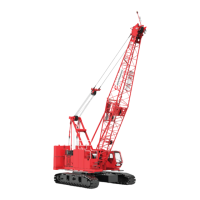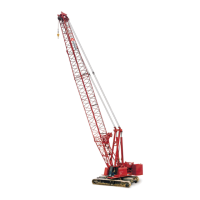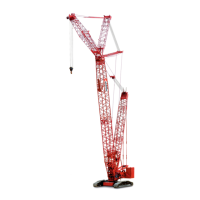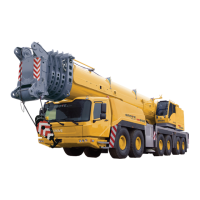HOISTS MLC300 SERVICE/MAINTENANCE MANUAL
5-14
Published 11-22-17, Control # 257-02
DRUM 4—BOOM HOIST
See Figure 5-8, Figure 5-9, and Figure 5-10 for the following
descriptions.
NOTE: The terms inboard A, inboard C, and inboard D
indicate the pump locations on the pump drive (2).
System A refers to the systems controlled by the
valve bank on the left side of the rotating bed.
System A is also referred to as Pump System A in
the MLC300 Main Display Manual.
System B refers to the systems controlled by the
valve bank on the right side of the rotating bed.
System B is also referred to as Pump System B in
the MLC300 Main Display Manual.
Drum 4 Overview
Drum 4 (16) is powered by an open-loop hydraulic system
consisting of two variable displacement hydraulic pumps (3
and 4) and one variable displacement hydraulic motor (18).
The drum 4 system contains a drum brake that applies
whenever the drum is not being operated.
Drum 4 also uses a pawl that provides a mechanical stop
when engaged. Pawl engagement occurs whenever the
drum 4 park switch is in the PARK position.
Joystick Control
Depending on crane configuration, drum 4 can be controlled
by joystick J1 on the left console or by joystick J5 on the right
console. For more information, see Drum and Control
Handle Identification in Section 3 of the MLC300 Operator
Manual.
The following operational procedures describe joystick J1 as
the controlling joystick.
Drum 4 Brake Overview
A brake is attached to the input of the drum 4 gearbox
located between the gearbox and the motor. The brake is
applied by spring force and released by hydraulic pressure.
The brake is controlled by joystick movement and the drum 4
park brake switch.
The pump 1 charge pump (6) provides the hydraulic
pressure to release the drum brake.
The brake must be fully released to allow the drum to rotate
for hoisting and lowering operations. To accomplish this, the
brake pressure must be above 10.5 bar (152 psi). Any
pressure below this could cause the brakes to remain
partially applied, which could damage the drum brake
system.
Only when predetermined conditions are met will the control
system actively release the drum brake. If hydraulic pressure
or electric current is lost, spring force applies the brake,
stopping the drum and holding it in position.
Drum 4 Brake Operation
UN-PARK Operation
Joystick J2 sends 24 V
DC
to the drum 4 park switch. The
park switch is closed in the UN-PARK position, causing the
switch to send 24 V
DC
back to joystick J2. Joystick J2
communicates the un-park command to the CCM-10 control
module via the controller area network bus (CAN Bus).
The drum brake remains engaged until drum 4 joystick J1 is
moved in either direction to hoist or lower a load. When
moved, joystick J1 communicates this information to the
CCM-10 control module via the CAN Bus.
When the CCM-10 control module receives both the un-park
command from joystick J2 and a hoist/lower command from
joystick J1, the CCM-10 control module relays the un-park
command to the IOLC31 control module via the CAN Bus.
Upon receiving the un-park command, the IOLC31 control
module sends 24 V
DC
to the drum 4 brake release solenoid
valve (14), energizing the solenoid. The solenoid valve shifts
position, routing hydraulic fluid to the drum brake (17) via the
brake defeat valve (22), releasing the brake.
ON-PARK Operation
When the drum 4 park switch is in the ON-PARK position,
the park switch is open, sending 0 V
DC
back to joystick J2.
Joystick J2 communicates the park command to the CCM-10
control module via the CAN Bus, which then relays the
command to the IOLC31 control module.
Upon receiving the park command, the IOLC31 control
module sends 0 V
DC
voltage to the drum 4 brake release
solenoid valve, de-energizing the solenoid. This causes the
solenoid valve to return to the default position, allowing the
hydraulic fluid in the drum brake (17) to return to the tank via
the brake defeat valve (22) and the drum 4 brake release
solenoid valve (14). The reduced hydraulic pressure allows
spring force to apply the drum brake.
When the drum 4 park switch is in the ON-PARK position,
drum 4 joystick J1 is inoperable.
CAUTION
Possible Machine Damage!
When raising or lowering the boom, do not use the drum
park switch to stop the boom movement, since this could
cause damage to the boom. Use the joystick for a
controlled smooth stop.

